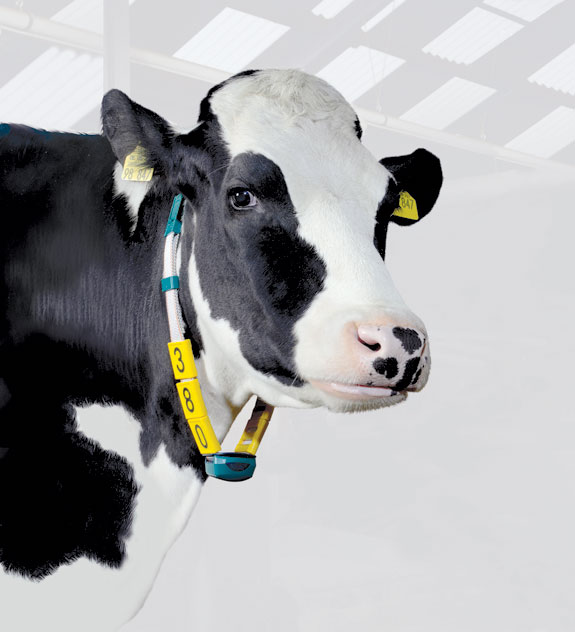In today’s dairy industry, if you bring up the topic of activity monitors, producers will most likely know what you are talking about. Most are aware of activity monitoring systems, though they may have started wondering whether these systems are right for their operations only recently.
James Bringe, dairy equipment consultant for GEA Farm Technologies , says that over the last two to three years of making farm visits, he has noticed a jump in interest from dairymen in activity monitoring technology.

However, he states that the bigger question producers should keep in mind is how these systems will benefit their operation now and in the years to come.
Dairy Management System 21 is the precision herd management system developed by GEA Farm Technologies.
Like most activity monitoring systems currently available, this one offers heat detection monitoring as part of a fully integrated system or in a stand-alone format. Bringe says this system has continually developed over the past 20 years, with the latest system planned for release in early 2012.
Activity monitors and heat detection
The fully integrated system can provide details on milk – its flow, weight and conductivity – in addition to activity measurement.
The latest version of the integrated system from GEA, Rescounter II+ , works in conjunction with the system’s software program to monitor and record, in a detailed way, a cow’s activity on a two-hour interval. This is interpreted using standard deviation measurements against her past history.
Bringe explains that there are three main components to this system. First and foremost, the system requires the use of tags which will monitor the cow’s activity. The second component is an ID point. The ID point is the location where the tag will be read; this could be the entryway or return alleys of parlors.
Some systems have readers installed at water fountains or other locations that cows visit frequently throughout the day. “This would be especially true for heifers because they typically wouldn’t come to the milking parlor,” Bringe says.
At the center of the system is DairyPlan C21 , the system’s software program and the third main component of the system.
This software program offers producers parameters that they can track by collecting production, reproduction and herd health data of each cow. “All the information related to the animal resides in the software program, and that’s our link to any of the system’s hardware pieces,” Bringe says.
Neck tags or leg tags?
Producers also have the option of placing the activity monitoring tags either on the neck of the animal, as a collar tag, or on the leg of the animal.
Bringe states that the cow’s foot was always a very easy positive movement to read in terms of activity because it consisted of simple back-and-forth movements as the animal walked.
He explains that the majority of all the systems sold in the past, including competitors’ systems, have typically been leg tag systems. If the producer is looking at monitoring activity on all of his animals, leg tags are usually used and stay on the animal year-round.
However, advancements in technology within the last three to five years have improved the capability of neck tags to monitor additional movements.
The new advancements in collar tags have incorporated the use of accelerometers, new algorithms and formulas to track specific movements. Another advantage of the newer technology is its ability to reduce the number of false positives, which has increased heat detection rates.
“If the producer plans to monitor heat activity only on open cows, then the standard procedure is to place neck tags on the cows,” Bringe says. “When the high-activity alarm goes off, she is bred – after confirming a pregnancy, the tag rotates to another cow.”
The challenge in data management
Bringe explains that the DairyPlan C21 software program is able to produce different types of reports and the information can also be presented graphically for the producer to comprehend better.
“It is always hard to interpret numbers, but when you look at things graphically and put all the pieces together, heats become fairly easy to pinpoint after a while,” Bringe says.
Producers can create reports or lists from the data by selecting from several predefined codes. At that point, he or she can alter and customize the reports to generate information tailored to the producer’s needs.
“Managing the information that is collected and basing decisions on that data is becoming the bigger challenge for dairymen,” Bringe says.
He explains that the extent of options this system offers the producer are numerous, but the payback of the system lies in the management decisions the producer makes based on the collected data. The primary result of using systems like this is that producers will find more cows in heat.
“By looking at the graphical data, producers can determine the onset of a heat cycle and can then better time their breeding, which naturally results in higher conception rates,” Bringe says.
He explains that other benefits of activity monitors include decreases in services per conception, increases in conception rates and a decline in days to first service, which ultimately result from the higher heat detection rates.
Once producers reach the point of finding cows in heat and successfully breeding them, other management options become available like choosing to use higher-genetic or sexed semen.
“What these producers will be doing is changing the genetic makeup of their herd faster,” Bringe says. “However, I still think the true benefits of these systems haven’t even been fully realized.”
Local and long-term support
Bringe says that a key discussion he has with dairymen revolves around the technical support that comes along with these systems. GEA Farm Technologies is currently working with its dealers to provide technical support to customers at the local level.
“These are technical pieces of equipment that need support, and like anything else, there will probably be a day when something doesn’t go right,” Bringe says. “It’s hard for me to provide service to a dairyman in South Dakota if I’m in Wisconsin, but a local dealer would be able to go out there and provide that hands-on support.”
In addition to local support, Bringe says they are challenged with providing technical support to producers on a long-term basis – a challenge shared by all the major vendors to the farm.
He explains that, as a company, they want to make sure their dealers are educated, know how to deliver and install these systems and also be there to provide long-term support.
“Dairy producers don’t think about buying something that’s only going to last a couple of years,” Bringe says. “They have high expectations of long-life systems because that means low cost of ownership over time which, in turn, helps bring a return on investment.”
Big plans in 2012
In 2012, the company plans to launch a system that incorporates wireless technology. The new system will be able to store the herd’s data off-site using cloud computing technology.
Producers will then be able to access their herd’s activity data via the Web using devices like smartphones. Bringe states that more details for this new system will be available following its launch early in the new year.
Bringe, however, believes there will be even more technological strides in the future and that the technology we see today will be different from what we will have tomorrow.
“I can see a lot of real significant changes coming forward in the next five to 10 years,” Bringe says. “Along with that, though, I believe that as activity monitoring systems get integrated into more dairies, it will probably become a standard way of operating.” PD
PHOTOS: If the producer is looking at monitoring activity on all of his animals, leg tags are usually used and stay on the animal year-round. Photos courtesy of GEA Farm Technologies.

-
Dario Martinez
- Editor
- Progressive Dairyman magazine
- Email an editor








